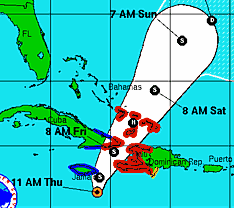Things are looking really, really bad for Haiti. A hurricane warning is now officially in effect for coastal Haiti and Tomas is expected to make landfall on Friday.
The UN Office for the Coordination of Humanitarian Affairs (OCHA) believes that up to 500,000 people will be affected by the storm. The hardest will will be the 1.3 million people living in tents, many of which are pitched on marginal lands. Between the cholera epidemic, the earthquake and the storm, aid workers, government, the Haitian people are struggling to cope with three concurrent humanitarian emergencies.
A hurricane striking Haiti this year was always a nightmare scenario. In 2008, three consecutive hurricanes pounded the country, causing millions of dollars in damage and killing and displacing thousands — but that was before a million people were forced to live in tents. But here we are in early November, and with hurricane season so very close to ending that it looked as if Haiti would finally get a stroke of good luck.
Alas, Tomas is shaping up to become the next terrible calamity for the Haitian people, made all the worse for the fact that the only thing standing between 1.3 million people and the outside storm are flimsy tents.
The Haitian government is calling for the voluntary evacuations of some of the larger displacement camps and encouraging people to find shelter with friends and family. The problem is, many people have nowhere to go. Hundreds of thousands of Haitians living in tents will have no choice but to ride out the storm. To get a sense of how deadly this might become, in September one heavy rainstorm killed ten people in flooding and mudslides. But that was just a regular storm–not a hurricane, tropical storm, or tropical depression.
The UN has put out an urgent plea for additional supplies. Aid workers are distributing ropes to fasten down tents and pre-positioning water and food supplies, with the expectation that roads will become un-passable for sometime. The United States Navy is even sending a warship to assist. These efforts will hopefully limit the damage — but expect the descruction to be extensive nonetheless.
Meanwhile, the UN expects the storm to accelerate the spread of cholera throughout the country. (Cholera, remember, is spread through contaminated water.) So far there have been 442 deaths and 6,742 hospitalized cases from cholera. The UN Office for the Coordination of Humanitarian Affairs warns, “Bad sanitary conditions in many parts of the country, combined with a huge amount of rain or flooding generated by the storm, in some cases combined with mud waters, are very likely to accelerate the cholera infection rate.”[emphasis mine]
As I said, things are looking very bleak. If you want to make a contribution to relief efforts, you can find an organization of your choice here.
